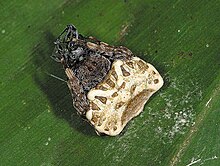
The genus Argiope includes rather large spiders that often have a strikingly coloured abdomen. These spiders are distributed throughout the world. Most countries in tropical or temperate climates host one or more species that are similar in appearance. The etymology of Argiope is from a Latin word argentum meaning silver. The carapace of Argiope species is typically covered in silvery hairs, and when crawling in the sun, they reflect it in a way that gives them a metallic, white appearance.

Myrmarachne is a genus of ant-mimicking jumping spiders that was first described by W. S. MacLeay in 1839. They are commonly called ant-mimicking spiders, but they are not the only spiders that have this attribute. The name is a combination of Ancient Greek μύρμηξ, meaning "ant", and ἀράχνη, meaning "spider".
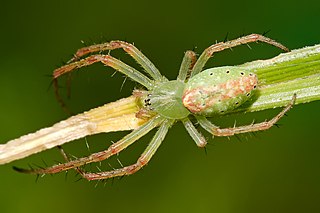
Cyrtophora, the tent-web spiders, is a genus of orb-weaver spiders first described by Eugène Simon in 1895. Although they are in the "orb weaver" family, they do not build orb webs. Their tent-like, highly complex non-sticky web is sometimes considered a precursor of the simplified orb web. These webs are aligned horizontally, with a network of supporting threads above them. These spiders often live in colonies. Females have a body length of mostly about 10 millimetres (0.39 in) long. Some members, including Cyrtophora cicatrosa, exhibit the ability to change colour rapidly.

Hogna is a genus of wolf spiders with more than 200 described species. It is found on all continents except Antarctica.
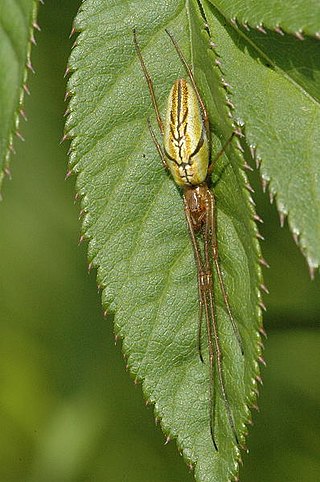
Tetragnatha is a genus of long-jawed orb-weavers found all over the world. It was first described by Pierre André Latreille in 1804, and it contains hundreds of species. Most occur in the tropics and subtropics, and many can run over water. They are commonly called stretch spiders in reference to their elongated body form and their ability to hide on blades of grass or similar elongated substrates by stretching their front legs forward and the others behind them. The name Tetragnatha is derived from Greek, tetra- a numerical prefix referring to four and gnatha meaning "jaw". Evolution to cursorial behavior occurred long ago in a few different species, the most studied being those found on the Hawaiian islands. One of the biggest and most common species is T. extensa, which has a holarctic distribution. It can be found near lakes, river banks or swamps. Large numbers of individuals can often be found in reeds, tall grass, and around minor trees and shrubs.

Arkys, also known as triangular spider or ambush spider, is a genus of Australian araneomorph spiders in the family Arkyidae, first described by Charles Athanase Walckenaer in 1837. They are often small, with a triangular shaped abdomen, and are found in Australia and some of its surrounding islands. They don't build webs, but can often be found on leaves and tips of flower heads. Their egg sacs are pinkish-orange and spherical, and are made late in the summer.
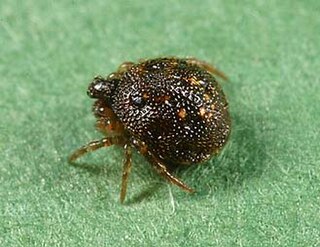
Phoroncidia is a genus of comb-footed spiders that was first described by J. O. Westwood in 1835.
Demadiana is a genus of Australian araneomorph spiders in the family Arkyidae, first described by Embrik Strand in 1929.
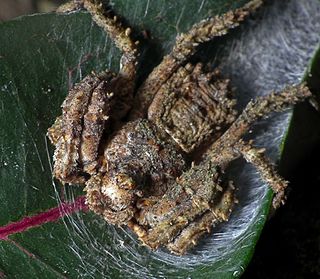
Stephanopis is a genus of crab spiders first described by Octavius Pickard-Cambridge in 1869. It was erected for five then newly described species, including S. altifrons, from Australia. Stephanopis was characterized by the high cephalic region with unequally sized anterior eyes disposed in a strongly recurved row, opisthosoma ending in several spiniform projections and dorsoventrally depressed habitus. According to Pickard-Cambridge, the single specimen used for the description of S. altifrons was dry-pinned. Therefore the specimen could not be properly examined, so it was not possible to determine if the specimen was adult. Moreover, he states his own sketch of the spider as “hasty”. This may explain why the somatic characters were inadequately described, genitalic features were not mentioned at all, and the illustrations were not detailed enough, making the species unidentifiable.
Hortophora is a genus of South Pacific orb-weaver spiders first described by V. W. Framenau, R. L. C. Baptista and F. S. M. Oliveira in 2021.

